Business plan 2013 to 2014
Updated 25 June 2014
1. Chief Executive’s message

I am proud to lead an agency that over the last year has delivered:
- the ‘ Best Overall Contact Centre of the Year’ awarded by the Contact Centre Association (CCA)
- Customer Service Excellence accreditation
- continuous insurance enforcement to combat uninsured driving
- nearly £40 million saving against £100 million annual running costs by 2014 to 2015
2013 to 2014 will be another challenging year for the agency as we manage a register of nearly 37 million vehicle records and over 44 million driver records and collect around £6 billion in vehicle excise duty.
During 2013, after planning and public consultation, we will be implementing the transformation and modernisation of our network services. This will mean the phased closure of 39 local offices. Managers will do all they can to assist dedicated and experienced staff to prepare themselves for something new.
Modernisation will mean centralising work in Swansea and will lead to efficiency savings. Customers will continue to receive high levels of service but through predominantly digital channels. We are also planning for motorists in Northern Ireland to have the option of relicensing their vehicle online.
We will pick up the pace on our IT contract let programme, working with a range of suppliers, we will take forward our contribution to the Government Digital Strategy, build modern (Greenfield) IT platforms and three further digital services announced by the Parliamentary Under Secretary of State:
- integrated enquiry platform: to handle 10 million enquiries a year from insurers and others
- vehicles online: to manage 17 million sale or disposal transactions every year
- personalised vehicle registrations: around 1 million transactions a year
A theme running through this business plan is making further improvements in our efficiency and effectiveness as we continue to build on the £39.7 million achieved to save £100 million in our annual running costs by 2014 to 2015. In recognition of this change to our operating cost base, we will conduct a review of fee income and future investment requirements and propose a strategy for the future that rebalances and limits charges imposed on motorists whilst ensuring the long-term continuation of DVLA services.
During the year ahead, we will take action after considering responses to consultations on:
- removing the insurance check when taxing a vehicle
- the future of the Department for Transport Motoring Services Group
I have announced that I will be leaving the agency in April 2013 to take up a post in the Department for Work and Pensions. DfT have commenced the search for my replacement whose responsibility it will be to deliver this plan and lead the agency forward.
Simon Tse
DVLA Chief Executive and Accounting Officer
March 2013
2. Who we are and what we do
2.1 Our vision and key purpose
DVLA is an Executive Agency of the Department for Transport (DfT) and is responsible for maintaining over 44 million driver records and almost 37 million vehicle records.
Our vision:
Customers are at the heart of our business and drive everything we do. Our digital services and our people exceed our customers’ expectations.
Our key purpose
Our key purpose is to ensure that complete and accurate registers of drivers and vehicles are held and we make them as accessible and as flexible as possible, to those who have the right to use them.
These registers underpin action by DVLA, the police and others to maintain the high levels of road safely experienced in the UK and the effective collection of vehicle excise duty (VED). DVLA registers are used to deliver other departmental and government initiatives such as traffic management and reducing carbon emissions.
We want to be seen as a world class organisation in managing the collection, storage and provision of accurate data relating to driving entitlements and vehicles and the collection of motoring taxes.
Digital services
Since 2002, DVLA has consistently developed new digital services making it easier for customers to transact with us whilst delivering significant savings. To go further, we now need to become an organisation that is digital by default.
Compliance and enforcement
The agency collects around £6 billion a year in VED and is responsible for limiting tax evasion to no more than 1% per year. We operate continuous insurance enforcement, a joint government and insurance industry initiative to combat uninsured driving.
DVLA also supports the police and intelligence authorities in dealing with vehicle related crime.
DVLA personalised registrations
DVLA personalised registrations offer a range of unissued registration numbers for customers to buy online or at auction. Since its launch in 1989, the agency has collected over £1.8 billion on behalf of the Treasury.
The purpose of this business plan
The purpose of this business plan is to map out our digital journey and show how the needs of our customers and partners will be met.
Our business plan is supported by DfT and the Cabinet Office and has been agreed by our sponsors.
Progress against performance set out in this business plan will be reported on our website.
DVLA Annual Report and Accounts 2013 to 2014 will detail the end of year performance.
For more information about DVLA, visit www.gov.uk/dvla
2.2 How we manage our organisation
DVLA Executive Board
The agency Chief Executive and Accounting Officer chairs an executive board (EB) of six executive and two non-executive directors. For more information about our EB visit our website.
The EB meet formally each month to monitor the achievement of business objectives, including progress against DVLA major change programme milestones.
The EB also deal with operational issues that are escalated to it from the groups that support it. These groups are accountable to the EB for the delivery of the Agency:
- operational key performance measures
- change portfolio
- procurement and commissioning activities
- financial performance and forecasts.
In addition, the Chief Executive Officer (CEO) and six executive members meet formally after the end of each quarter within the financial year to review the detailed financial performance and agree any changes to forecast and budgets for the rest of the year.
The CEO and the finance director attend four audit committee meetings each year, as observers.
Change
The agency manages a wide portfolio of change which commits it to delivering its services in a digital form, accessible to a wide range of users both directly and through intermediaries.
The principles of Civil Service Reform, Digital by Default, efficiency growth and open data agendas shape and drive the change portfolio.
The Transformation Director is responsible for the agency Change Portfolio Office who co-ordinate planning, resource prioritisation and progress reporting across all the change initiatives underway.
Programmes of work have been established to deliver specific high level objectives and each programme commissions the projects it needs to deliver individual outputs.
Risk
DVLA audit committee supports the CEO with advice on matters of governance and adequacy of controls in terms of operations and risk management.
The EB review corporate risks monthly to provide guidance to managers on how to respond to risks they have identified. The risk policy, generic risks and risk horizon scanning is refreshed annually.
For more information on DVLA governance and risk management visit DVLA Annual Report and Accounts 2011 to 2012.
Transparency and accountability
Our digital business plan provides monthly/quarterly updates on performance against business objectives. We also publish contract and expenditure details. Our corporate documents now provide information that is more accessible. For more information on transparency and accountability visit Gov.uk.
3. How the Agency is changing
3.1 Our strategic direction
In the ten years since DVLA’s first electronic transaction was introduced, the demand for digital services from our customers has grown to an extent that we have been unable to meet. We aim to put this right.
Digital by default
Since 2002, the DVLA change programme has consistently introduced services that have reduced the volume of paper transactions by 58% through online or digitally assisted services (via the web, the post office or other commercial enterprises).This digital direction is the core of the DVLA operational change programme. We will consistently aim to provide the most efficient, effective services to meet the needs of a diverse but ever growing digitally aware customer base, whilst recognising the needs of the important minority through assisted digital services.
To ensure that DVLA is in step with the wider Civil Service Reform Plan, the Government Digital Strategy and The Red Tape Challenge we have reset our organisational vision. Our new vision summarises where we are going, not where we are today:
Customers are at the heart of our business and drive everything we do. Our digital services and our people exceed our customers’ expectations.
This is no easy task. To achieve the vision we will need to become an organisation that is digital by default, with services so good that people want to use the digital one first. This in turn, will involve working relentlessly to:
- redesign our business and processes around customer needs to cater for the digital world that we all now live in and keep up with future technology changes
- develop our staff and managers so that we have the skills to deliver, know what we are working to achieve and can all apply this strategy in our day to day work
- change our culture to become a responsive, agile and empowered organisation
- ensure personal data is held safely, increasing accuracy and continuing to achieve high levels of motoring tax compliance
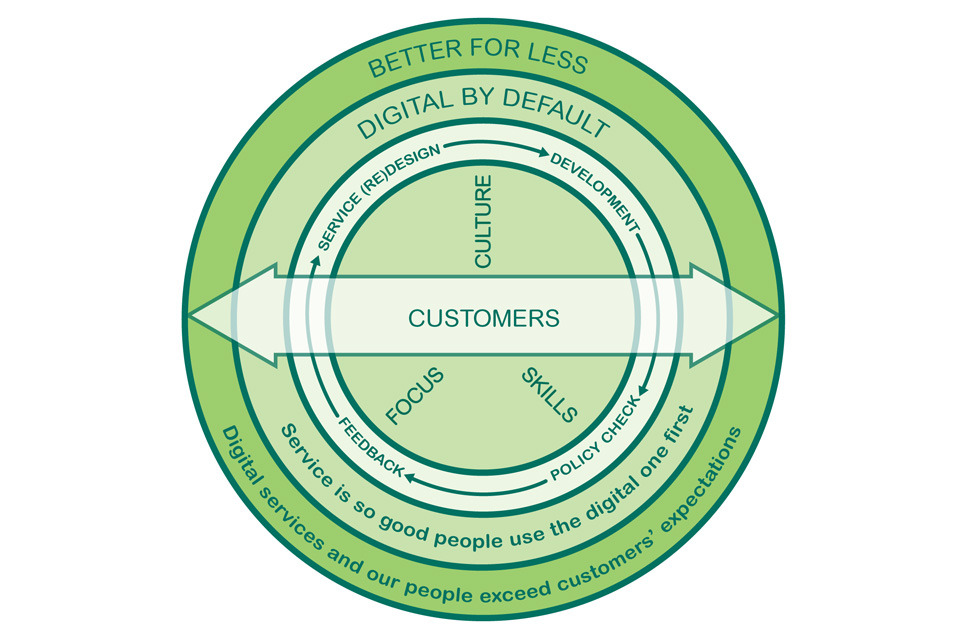
Vision diagram
Our customers are many and varied, they include:
- motorists
- businesses
- ministers and their officials (in DfT and other government departments)
- other government agencies and organisations
- the police
In short, we want them to receive even better services at a lower cost.
We will measure our progress in delivering the vision against the following headline milestones to:
- review all services with more than 100,000 transactions per year from a ‘user needs’ perspective by March 2014
- deliver three exemplar digital services – vehicles online, personalised registration and integrated enquiry platform by 2015
- ensure all services with more than 100,000 transactions per year will be available by digital and assisted digital channels by 2017
- achieve over 80% digital take up for over 80% of our services by 2020
These initial milestones will be reviewed annually with progress reported in our Annual Report for 2013 to 2014. We intend to add milestones to:
- increase first time task completion rates for our core services
- increase user satisfaction with our services
- increase digital take-up before 2020
- reduce our baseline operating expenditure
- reduce the costs per transaction of our core services reducing fees for the motorist
IT Contract Let
During 2013 to 2014 DVLA will prepare the ground for our major IT contract let. This will reduce the future cost of hosting the driver and vehicle database and open up the prospect of introducing state of the art open source systems to replace the agency’s tired and out of support bespoke software.
We will accelerate the actions we are taking to replace our systems with modern, industry standard, open-source systems which will be more flexible to meet changing demands and which can be supported and maintained at much lower cost.
In 2013 to 2014 we will plan and agree how we will move our services to new systems and when we will de-commission and shut down old systems. During the year we will work to ensure the agency and its staff have the skills and structures needed to manage this transfer, the new systems and the new contracts and support arrangements we need to purchase. Our plans are in line with the Government’s ICT and Digital strategies and standards.
Modernisation of network services
During the year, DVLA will complete the closure of all 39 local offices and regional enforcement offices. We will use 4,500 post offices offering front office counter services to carry out assisted digital transactions for customers. We are also planning to introduce digital and assisted digital transactions for our customers in Northern Ireland, improving service quality and convenience.
Increased efficiency
With the procurement of new and improved contracts for the purchase of plastic cards for driving licences and for the provision of vehicle tax enforcement services, the first phase of our efficiency programme will end. The efficiency programme will achieve a further £60 million a year savings and will lift the agency’s savings to £100 million a year by 2015.
We will pursue further savings as we replace our IT systems and customer take-up of digital services reaches full potential with users directly managing their own data more effectively. This will save money avoiding the cost of paper handling and for customers the need to travel to transact across a counter or to post documents to DVLA.
Efficiency
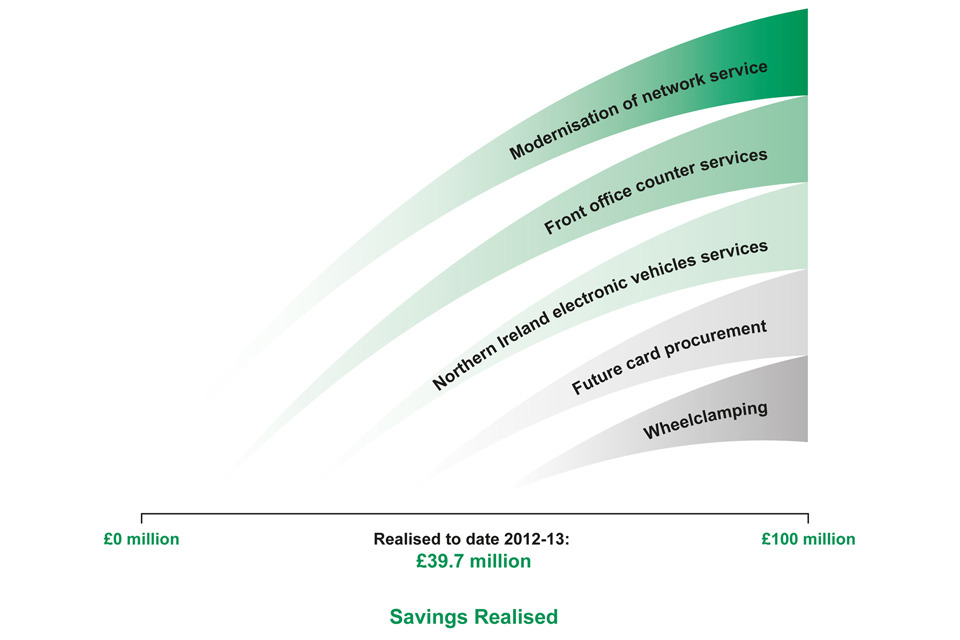
Efficiency diagram
Other significant deliveries in 2013 to 2014 will be:
- digital access being explored with the motor insurance industry to allow them to check driver records and cut the cost of motor insurance policies
- new online facilities to allow motorists to report a change of vehicle keeper and start a personalised registration transaction, these were promised in the DfT Digital Strategy
Risks to delivery of the change portfolio
DVLA’s change portfolio will require significant investment to make savings that will recur year-on-year. The DFT Digital Strategy puts in place a series of checks and assurance reviews to ensure investment is well focused before too much money is spent. Whilst we steer our proposed changes through assurance stages and pay careful attention to the feedback and guidance we receive, there is a risk of delay to the delivery of benefits.
There are particular risks associated with the scale and complexity of the contract let programme.
We will mitigate these risks by giving early warning and access to a wide range of reviewers to our proposals during the process, so that we present and validate evidence to show that we are pursuing a best value approach.
3.2 Policy development
DVLA will continue to comply with EU statutory requirements and is supporting the government commitments to reducing the burden of regulation following the launch of the DfT Road Transport Red Tape Challenge.
DVLA will work with the Cabinet Office and make use of legislative reform powers to expand opportunities for digital by default. We will make the case for revising legislation and policy, we will analyse DVLA data systems to support evidence based policymaking and provide data reports to DfT and wider government. The agency is helping to simplify and reduce the compliance burden imposed on both the public and business. We will continue to be the main contact point with DfT and ministers and ensure compliance with regulation and consultation principles.
During 2013 to 2014 we will
- support the Red Tape Challenge by:
- stopping the need for statutory off road notification, once declared off the road for the first time
- issuing vehicle registration certificates to fleet operators only on request
- removing the requirement for the check of motor insurance certificates during vehicle excise duty transactions
- introduce a road levy for HGV road users in the UK by April 2014
- support the delivery of an electronic enquiry service for sharing DVLA data with authorised recipients
3.3 Joined up working across government
DVLA will continue to work across government as one of the leaders in the government digital by default strategy.
During 2013 to 2014 we will
- support Department of Work and Pensions move away from Disabled Living Allowance to Personal Independence Payments
- continue work to introduce e-services in Northern Ireland which will give parity of service with motorists in the rest of the UK
- reduce VAT evasion - work with HM Revenue & Customs to introduce an electronic system to ensure that importers have paid VAT before registering and licensing an imported vehicle
- update the technology that allows DVLA to check certain driving licence transactions with other EU Member States
This will:
- reduce document fraud and forgery
- reduce driving licence tourism, while improving road safety
- facilitate the free movement of driving licence holders
- speed up the driving licence issue and verification process
4. Our Plans for 2013 to 2014
4.1 DVLA key performance measures
Reform
| DVLA key measures | |
|---|---|
| 1 | Modernising DVLA services. Centralise operations and close local services network by * Winter |
| 2 | Digital Services. Improve electronic take-up by March 2014 |
| Electronic vehicle licensing to 58% | |
| Overall take-up (drivers and vehicles) to 54% | |
| 3 | Shared Services Migration. Complete business readiness for migration to a new shared services platform, including substantial progress of business rule configuration and interface development by March 2014 |
Operational
| DVLA key measures | |
|---|---|
| 4 | Suppress vehicle registration certificates to fleet owners. Complete initial delivery of systems that issue vehicle registration certificates to fleet operators only on request by *Winter |
| 5 | Indefinite Statutory Off Road Notification. Deliver systems that stop the need for repeat Statutory Off Road Notification once declared off the road for the first time by *Winter |
| 6 | Heavy goods vehicle road user levy. DVLA will collect VED and levy a single payment for HGV vehicles over 12 tonnes from March 2014 |
| 7 | Customer Service. Achieve 19 out of 20 customer service measures |
| 8 | Accuracy. To maintain accuracy so the registered vehicle keeper can be traced from details held on our record in 95% of cases |
| 9 | Freedom of information. Provide a 93% response within 20 working days |
| 10 | Parliamentary Questions. Provide a 100% response within due date |
| 11 | Ministerial correspondence. Provide a 100% response within 7 working days |
| 12 | Official correspondence. Provide an 80% response within 20 working days |
| 13 | Prompt payment. Pay 80% supplier invoices within 5 working days |
| 14 | Customer complaints. To reduce the number of complaints not resolved at first contact (as compared with 2012 to 2013) by 10% |
Finance and efficiency
| DVLA key measures | |
|---|---|
| 15 | Agency Finance. Make progress towards £100million a year reduction in operating costs by the end of 2014 to 2015 against a 2010 to 2011 baseline £60 million. Deliver financial performance in line with plan as detailed in Annex A |
| 16 | Workforce. By 31 March agency workforce (full time equivalent)* will number 4,950 |
| 17 | Sickness Absence. Ensure the average number of working days lost (full time equivalent)** due to sickness is significantly less than the DfT standard 7.5 days lost at 6.8 days |
| 18 | Protecting the environment. Cut carbon emissions by 20% from agency activities by 31 March 2014 (when compared with 2009 to 2010 baseline |
*Will be delivered by 28 February 2014. **see glossary of terms
Customer service measures
| Customer Service Excellence (CSE) Standard | Measure 2013 to 2014 |
|---|---|
| Retain accreditation of the CSE Standard | Achieved |
| Customer Contact Association (CCA) Standard | |
| Retain accreditation of the (CCA) Standard | Achieved |
| Driving licences | |
| To deliver a first driving licence within 8 working days | 98% |
| To deliver a vocational licence within 8 working days | 98% |
| To deliver an ordinary driving licence within 10 working days | 98% |
| To deliver a digital tachograph renewal within 8 working days | 98% |
| Medical investigations | |
| To conclude all cases and deliver a licensing decision within 90 working days | 90% |
| Vehicle registration document | |
| To deliver a first registration certificate, excluding cherished transfers, within 14 working days | 95% |
| To deliver a change on a registration certificate within 14 working days | 95% |
| To deliver a registration certificate from an application (notifying changes to the registration certificate) within 30 working days | 95% |
| Vehicle excise duty refunds | |
| To deliver a refund due within 30 working days | 95% |
| Customer service | |
| To answer calls queued to advisor | 95% |
| To deliver a recognised quality of service standard in the contact centre | 85% |
| To answer an email within 3 working days | 95% |
| Keep average local office queuing time to no more than 15 minutes | 15.00 |
| To deliver a cherished transfer within 7 working days | 95% |
| Customer complaints | |
| To acknowledge a complaint within 1 working day | 100% |
| To maintain or improve on last year’s performance sending a substantive response within 10 working days | 98% |
| MP correspondence | |
| To acknowledge correspondence within 1 working day | 100% |
4.2 Front line service delivery
Digital services
As a leader in the delivery of government online services, DVLA will continue to support the government ‘digital by default’ agenda by developing new digital transactions and improving existing services.
DVLA continues to play a big part in contributing to the delivery of the DfT Digital Strategy.
DVLA digital services are now available on a new single government website Gov.UK.
During 2013 to 2014 we will
- actively pursue opportunities to further improve the usability of our online vehicle licensing service
- review the barriers that exist in the driving licence ten year renewal online process
- seek to increase take-up of the digital channel with a view to removing the paper channel
- handle digitally applications presented to our counter service provider (which includes a proportion of assisted digital help)
- carry out an end-to-end review of the drivers first application, to allow customers greater choice and explore opportunities to use photographs from a wider range of sources than the current paper or Identity and Passport Services route
- work more digitally through improving and re-designing internal processes, engaging with customers through digital channels for example social media
- pursue initiatives to encourage under represented customer groups to use online services
- drop Government Gateway registration letters and replace with email
- remove the insurance check at relicensing, so that more customers can transact online
- put users needs at the heart of our digital service design and drive digital take-up wherever possible
- put forward proposals to stimulate further and faster digital take-up
- continue to promote digital self-serve channels to lead customers away from legacy paper channel

Channel strategy
Data Input
During 2013 to 2014 we will:
- continue to explore opportunities for efficiency improvements in the way we handle non-digital transactions
- increase the proportion of paper transactions scanned to image
- centralise transactions from the local services network into the central data capture unit in Swansea
- increase the proportion of legacy paper transactions received which are digitised and processed as an image rather than a physical document
Local services network
During 2013 to 2014, DVLA will complete its programme of modernisation of the local services network.
During 2013 to 2014 we will
- deliver a controlled closure of the network of 39 DVLA local offices by winter 2013 moving transactions wherever possible to digital channels
- continue to provide current levels of customer service at the local offices until their scheduled closure date
- maintain customer service quality at published levels through to closure programme
The closure of the local offices will contribute significantly to the £100 million annual cost savings target by 2015.
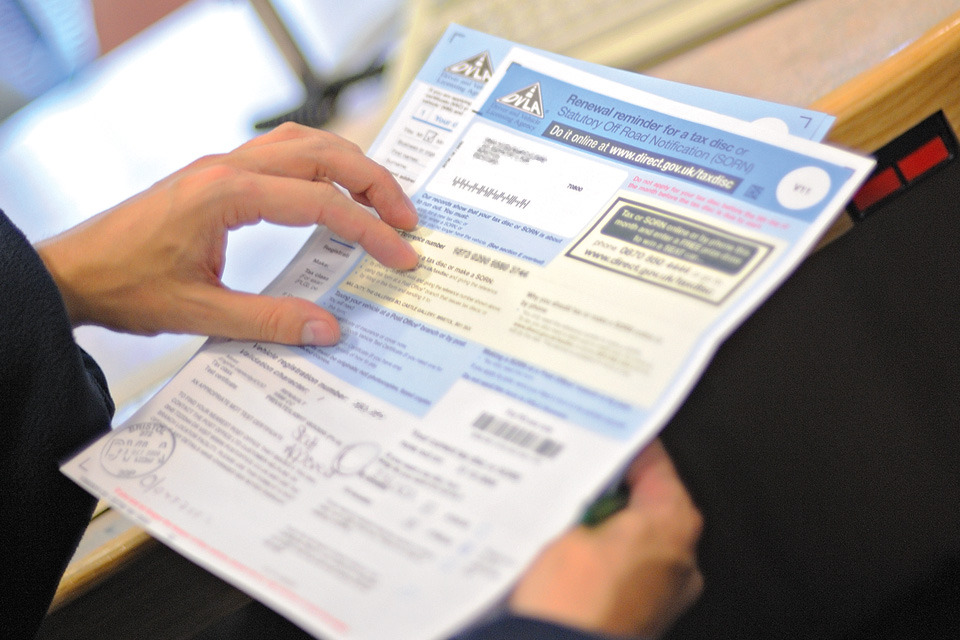
Enforcement
The Agency will use a range of targeted enforcement measures and clear and effective messaging to customers, which will enable them to become/remain compliant with their legal responsibilities as drivers and vehicle keepers. These enforcement measures include fixed penalties, prosecution, debt collection and wheelclamping, all used as a proportionate and increasing suite of enforcement tools.
During 2013 to 2014 we will
- limit vehicle tax evasion to below 1%
- reduce the number of taxed vehicles who do not have insurance on the motor insurance database by a further 5% on the 2012 to 2013 year-end position
- engage with local court services and HM Courts and Tribunals Service to deliver a more efficient and streamlined prosecution interface
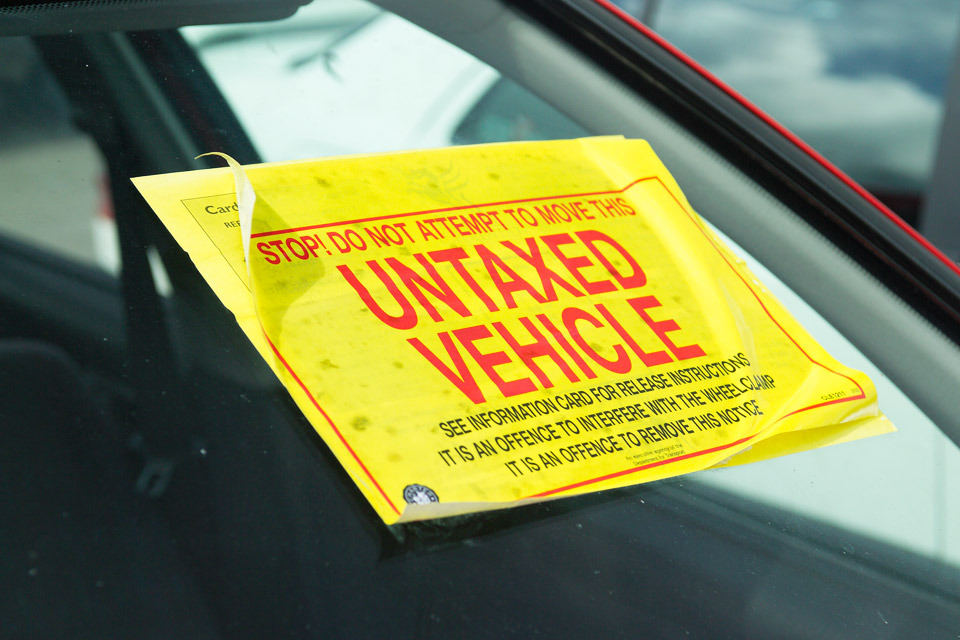
Output services
DVLA lead the way in government in the production of secure cards. Output services produce cards, print documents and send them to customers.
During 2013 to 2014 we will
- introduce cards from a new supplier
- offer services to others across government and continue to review our operating model to ensure it is the most efficient and effective way to deliver our services internally and to wider government
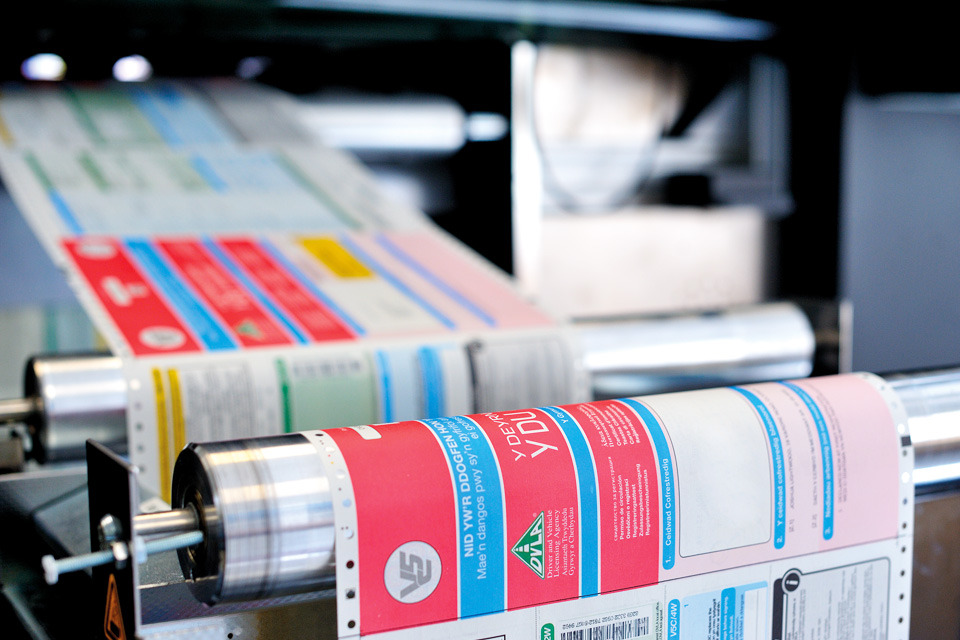
Drivers accuracy
The Agency will continue to identify issues and explore better ways to improve the accuracy of the driver record.
During 2013 to 2014 we will
- propose a programme of activity to improve the accuracy of the drivers register
- work through an agreed programme
- scope, test and propose a future measure for driver accuracy
DVLA Contact centre
DVLA’s contact centre were recognised in 2012 by the Customer Contact Centre Association, as leaders of the public sector in the delivery of contact centre customer services.
During 2013 to 2014 we will:
- handle more vehicle and continuous insurance enquiries
- deal with calls previously answered by the Department for Transport
- answer straight forward enquires received through the interactive voice recognition system, allowing the more complex enquiries to be dealt with by an advisor
- continue to gather customer feedback in order to improve our service
- improve our Welsh language service to customers
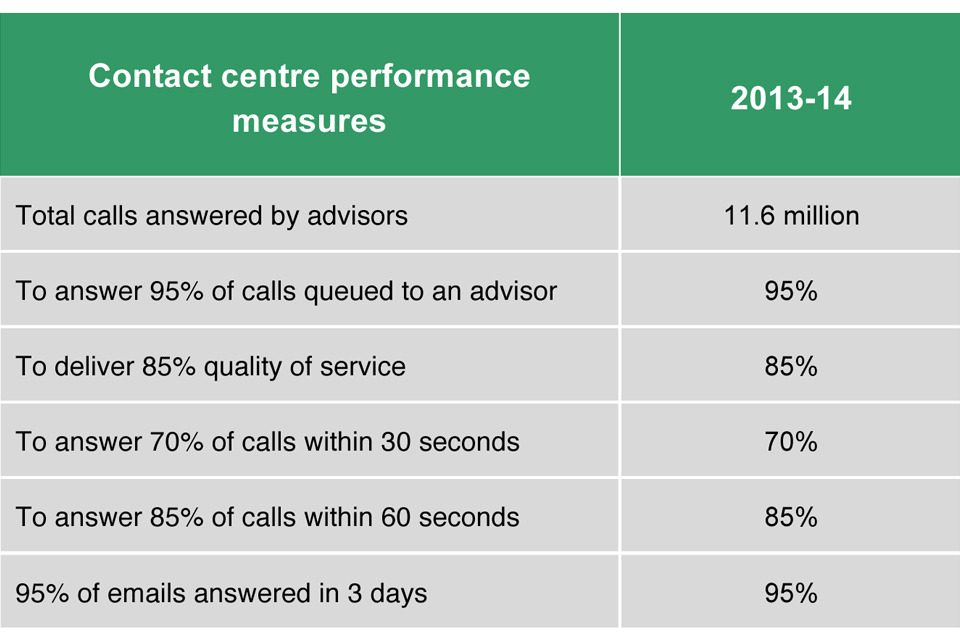
Contact centre performance
Casework
DVLA casework encompasses a wide range of diverse and detailed driver and vehicle customer communications. These include medical assessments, driving endorsements/disqualifications, release of data to those with the right to use it and dealing with both customers and third parties (for example courts, GPs and the motor trade) on complex driver and vehicle cases.
During 2013 to 2014 we will
- offer alternative, digital channels for customer correspondence on casework
- identify and eliminate avoidable casework
- revolutionalise our doctor and optician services
- continue to investigate suspected fraud
- introduce a digital business processing tool and further online forms for drivers notifying or updating a medical condition
Customer complaints
DVLA is committed to improving the way it handles complaints, achieving resolution at the earliest opportunity for our customers. Customer complaints received at the agency is relatively low in comparison to the amount of correspondence we receive. Our objective for 2013 to 2014 is to reduce the number of complaints not resolved at first contact (as compared with 2012 to 2013) by 10%.
During 2013 to 2014 we will
- identify why previous complaints have escalated to the next step in our complaint procedure and understand what we could have done differently
- respond to more customers using the method they prefer
- learn from this information and improve the investigation process
- give our customers the option to discuss their case over the phone so that we can quickly clarify any points raised and bring the matter to a conclusion as soon as possible
- improve the quality of our written communication so that we clearly answer all the customers questions; offering a solution and explaining where we went wrong
- work with our operational teams to highlight the common causes of complaints and make sure that corrective action is taken
- make our complaint process more user friendly by giving our customers the name and contact details of their case owner as soon as we receive a complaint
- listen to what customers tell us and make sure that we fully consider all suggestions so that we make our service more effective

5. Supporting delivery of our plan
5.1 Information services
DVLA information services maintain the day-to-day operations of the business, identifying issues and resolving incidents.
During 2013 to 2014 we will
- continue to support the government digital by default agenda to provide easier and more secure access to services, by ensuring ICT projects and services receive expert IT security advice
- work towards certification under the CESG Certified Professional Scheme to show in house skill levels are rising
- support ongoing payment card industry data security standard compliance through enhanced alerting and compliance monitoring
- prepare for transition of IT services to new providers in 2015
- support forthcoming major Public Service Network (PSN) changes to protect live service. PSN changes will drive cost improvements and have opportunities to refresh an ageing estate
5.2 Commercial services
DVLA commercial services group act as the primary area of the business that protects the agency commercial interests.
During 2013 to 2014 we will
- continue to lead the commercial side of the move to new, more flexible and lower cost ICT provision
- manage call off contracts for DVLA to get best value
- work closely with the DfT transition team from March 2013 to develop a strategy to support transition to a Cabinet Office led shared services framework contract
- complete business readiness for migration to a new shared services platform, including substantial progress of business rule configuration and interface development
- work with the Government Procurement Service to develop a managed service provider framework for medical services and ultimately to call off services in 2013
5.3 Financial management
In 2013 to 2014, DVLA will spend £507 million of which £389 million is raised through fees, £157 million on staff costs and £310 million on purchasing goods and services from third parties (see Annex A).
During 2013 to 2014 we will
- restructuring of services - ensure proper accounting for processes transferred from local offices and enforcement centres without additional resource requirement
- shared service - plan, prepare and deliver financial services to the business through transition to a new shared service provider and start preparations for the migration to a new IT platform
- merchant acquirer - manage the contract to generate sustainable savings against operating expenditure
- fees strategy - develop and agree a new strategy for our fees, taking into account savings made in light of the transformation of our services, as well as potential future investment in a ‘greenfield’ IT estate
- efficiency - monitor, report and offer a robust challenge to the Agency £100 million efficiency plans ensuring a fully auditable position is reported at year end
Risk
There is uncertainty over the scale and scope of the staff time and cost we will have to bear through transition to a new shared service provider and preparation for migration to a new IT platform.
5.4 Human resources
DVLA Human Resources (HR) will continue to provide people processes that are aligned to wider government HR strategy. These processes will be tailored and developed to ensure they enable DVLA to operate effectively and efficiently.
During 2013 to 2014 we will
- assist, support and advise staff through the closure programme of our enforcement centres and local offices
- transfer and recruit for the centralisation of services at Swansea
- launch the new Civil Service wide competency framework in DVLA
- implement a programme of training to DVLA staff to develop capability in four priority areas: commercial, digital programme, project management, leadership and management
- review how staff performance is measured to ensure that performance issues are identified and managed effectively and that high performance is recognised
- establish a structured apprenticeship programme
- develop appropriate structures to support significant changes associated with the main change programmes
- deliver appropriate terms and conditions along with other priorities highlighted within Civil Service Reform
Risk
We will be losing experienced staff when local offices close, this increases the risk that Swansea lack or fail to retain the range of capability needed. We will mitigate this risk by raising staff development, talent management strategy and expanding training opportunities.
DVLA Workforce 2013 to 2016
| End of year | DVLA FTE* | Front line FTE* | Back office FTE* |
|---|---|---|---|
| March 2013 | 5,635 | 4,490 | 1,145 |
| March 2014 | 4,950 | 3,950 | 1,000 |
| March 2015 | 4,880 | ||
| March 2016 | 4,880 |
*See glossary of terms
5.5 Estate management
The Agency estate is flexible, efficient and effective, which enables it to meet the changing requirements of the business, particularly those arising from the closure of the local services network.
During 2013 to 2014 we will
- manage the closure of local offices and the divestment of lease commitments in the most cost effective and least disruptive manner
- dispose of local office leasehold properties in the most effective way that supports the requirements of the Cabinet Office/government property unit
- continue to identify opportunities to share our property and facilities with other government departments in order to minimise our running costs, while also contributing to efficiency savings to the Chancellor of the Exchequer
- maintain the effective use of our accommodation, ensuring we adhere to best practice standards of no less that 8m2 per person and no more than eight desks per 10 staff

6. Sustainability
DVLA is aware of the need to be sustainable. There are increasing environmental, economic and social pressures and the agency is developing its business in a way that will enable it to succeed.
The government has set its departments and executive agencies a number of targets to achieve, the Greening Government Commitments (GGC). These targets will be achieved over a five-year period (starting from a 2009 to 2010 baseline) by 2014 to 2015. In addition, we have set our own internal targets to improve our performance.
As well as ongoing improvements in energy efficiency, DVLA has significant initiatives in progress:
- consolidating and reducing the number of data centre rooms by virtualising and increasing utilisation of servers
- reviewing the lighting across the whole estate
- investing in renewable energy such as photovoltaic panels and wind turbines
In light of the closure of DVLA local services network, there will be an increase in travel during 2013 to 2014. The agency has not set a travel related reduction target for the year (we expect an increase from 2010 to 2011 in the total amount of travel for one year only). Once the local offices have closed, we expect our business travel to reduce.
6.1 Waste minimisation and disposal
DVLA will continue to review its waste. The agency separate and monitor waste through 45 different streams. These streams include waste items such as photocard licences, toner cartridges, trade plates, aluminium cans and glass. DVLA’s biggest waste stream is paper, this accounts for 64% of total waste. Whilst the agency recycles all paper through the Government Procurement Service closed loop initiative, we recognise that there is more we can do to reduce the amount of waste we produce.

6.2 Disposal
DVLA recycle in excess of 80% of waste, over the next two years we will increase this by 5% by examining the waste sent to landfill sites. Much of the Agency waste fits into established recycling schemes; however, our processes for sorting waste can be improved.
During 2013 to 2014 we will improve segregation and overall waste disposal and look for further improvements to the waste paper produced via the production processes.
6.3 Water Consumption
The Agency has installed rainwater harvesting, waterless urinals and low flush toilets across its estate. We will continue good practices such as water auditing, replacing valves where appropriate and monitoring the consumption checking for unusual patterns or possible leaks.
During 2013 to 20-14 we will maintain water consumption to an average of less than 6m3 per person per year in our administrative estate (m3/FTE)
6.4 Transparency Commitments
As well as the Greening Government Commitments (GGC), we will be continuing work on our transparency commitments.
6.5 DVLA sustainable development plan

DVLA sustainable development plan
7. Annexes
7.1 A. Financial summary – projections
| Income and expenditure | Forecast 2012 to 2013 £ million | Business plan 2013 to 2014 £ million |
|---|---|---|
| Statutory fee income | 389.3 | 388.9 |
| Commercial fee income | 66.9 | 65.8 |
| Other income | 12.3 | 4.7 |
| Total income | 468.5 | 459.4 |
| Staff costs | (156.3) | (157.4) |
| Contingent labour | (0.9) | (1.2) |
| Agents fees | (66.6) | (41.8) |
| ICT charges | (135.4) | (130.0) |
| Accommodation | (34.4) | (32.1) |
| Consultancy and professional services | (2.9) | (5.8) |
| Postage and printing | (60.8) | (54.0) |
| Depreciation | (31.3) | (32.0) |
| Other costs | (55.2) | (52.9) |
| Total expenditure | (543.8) | (507.2) |
| Net operating costs | (75.3) | (47.8) |
| CFERs due to the consolidated fund | (94.4) | (98.0) |
| Vehicle excise duty collection and enforcement covered by supply funding | 179.3 | 16.2 |
| Fees surplus | 9.6 | 16.4 |
| Forecast 2012 to 2013 £ million | Business plan 2013 to 2014 £ million | |
|---|---|---|
| Resource DEL | 176.0 | 172.0 |
| Resource AME | (6.3) | (26.2) |
| Total resource and AME | 169.7 | 145.8 |
| Capital | 23.3 | 27.1 |
| Statement of financial position | Forecast 2012 to 2013 £ million | Business plan 2013 to 2014 £ million |
|---|---|---|
| Non-current assets | ||
| Property, plant and equipment | 84.5 | 86.1 |
| Intangible assets | 87.9 | 81.4 |
| Trade and other receivables due after more than one year | 3.4 | 2.9 |
| Total non-current assets | 175.8 | 170.4 |
| Current assets | ||
| Trade and other receivables | 52.5 | 36.1 |
| Cash and cash equivalents | 35.1 | 20.2 |
| Total current assets | 87.6 | 56.3 |
| Total assets | 263.4 | 226.7 |
| Current liabilities | (72.5) | (48.5) |
| Total assets less current liabilities | 190.9 | 178.2 |
| Non-current liabilities | (68.0) | (46.1) |
| Asset less liabilities | 122.9 | 132.1 |
| Taxpayers’ equity | ||
| General fund | 78.4 | 87.6 |
| Revelation reserve | 44.5 | 44.5 |
| Total taxpayers’ equity | 122.9 | 132.1 |
| Statement of cash flows | Forecast 2012 to 2013 £ million | Business plan 2013 to 2014 £ million |
|---|---|---|
| Net operating cost | (75.3) | (47.8) |
| Reconciliation to cash | ||
| Interest payable | 1.7 | 1.6 |
| Depreciation | 31.3 | 32.0 |
| Movement in trade and other receivables | 5.5 | 16.9 |
| Movement in trade and other payables | 0.5 | (18.1) |
| Movement in provisions | (6.3) | (26.2) |
| Net cash flow from operating activities | (42.6) | (41.6) |
| Capital expenditure | (23.3) | (27.1) |
| Net cash flow from investing activities | (23.3) | (27.1) |
| Finance costs | (1.7) | (1.6) |
| Capital element PFI | (1.8) | (1.9) |
| DfT supply funding cash requirement | 160.9 | 155.0 |
| Net cash flow from financing activities | 157.4 | 151.5 |
| Payments of amounts due to the consolidated fund | (98.0) | (97.7) |
| Payment of excess cash reserves to HMT | (61.8) | 0 |
| Net (decrease) in cash balance | (68.3) | (14.9) |
| Opening cash balance | 103.4 | 35.1 |
| Closing cash balance | 35.1 | 20.2 |
7.2 B. Volume forecasts
| Transaction volumes | 2012 to 2013 Forecast outturn | 2013 to 2014 Business Plan forecast |
|---|---|---|
| Changes to a registration document | 18,180,279 | 18,241,127 |
| Cherished transfer/assigned marks | 1,180,375 | 1,238,026 |
| Digital tachograph card issue | 300,503 | 300,503 |
| Driver customer enquiries | 5,587,987 | 5,972,389 |
| Driver fee paying enquiries | 1,824,265 | 1,980,094 |
| Duplicate driving licence | 1,057,190 | 1,079,809 |
| Duplicate registration document | 1,102,340 | 1,030,293 |
| Duplicate vehicle licence | 346,268 | 345,551 |
| Exchange driving licence | 903,576 | 897,852 |
| First application for driving licence | 1,030,099 | 1,001,044 |
| First registration of vehicles | 2,424,645 | 2,434,739 |
| Interactive voice recognition customer enquiry/ drivers | 2,100,095 | 2,128,555 |
| Interactive voice recognition customer enquiry /vehicles | 1,223,383 | 911,226 |
| Drivers medical casework | 753,000 | 810,000 |
| Other driver transactions | 5,517,453 | 4,762,027 |
| Other vehicle transactions | 34,878,740 | 35,740,701 |
| Renewal of driving licence | 1,643,666 | 1,639,694 |
| Replacement driving licence | 2,340,889 | 2,370,106 |
| Sale of marks | 214,535 | 214,535 |
| Ten year renewal of driving licence | 2,272,919 | 2,285,582 |
| Vehicle customer enquiries | 5,343,072 | 5,637,451 |
| Vehicle fee paying enquiries | 2,706,000 | 2,706,000 |
| Vehicle insurance interest | 35,400 | 35,400 |
| Vehicle licensing | 43,944,351 | 45,474,989 |
| Vehicle police enquiries | 657,531 | 657,531 |
| Vocational driving licence | 242,165 | 250,883 |
| Total | 137,810,725 | 140,146,108 |
7.3 C. Glossary of terms
| Accounting officer | A person appointed by the Treasury or designated by a department to be accountable for the operations of an organisation and the preparation of its accounts. |
|---|---|
| Annually Managed Expenditure (AME) | Spending included in Total Managed Expenditure, which does not fall within Departmental Expenditure Limits (DELs). Expenditure in AME is generally less predictable and controllable than expenditure in DEL. |
| Assets | Tangible asset (sometimes referred to as fixed assets) are items that are purchased as capital expenditure and have a physical substance. Intangible assets are also capital purchases but do not have a physical substance, for example software licence, project development. Non-current assets are those that are not expected to be turned into cash within one year during the normal course of business. |
| Capital element PFI | The private initiative is a way of creating public, private partnerships by funding public infrastructure projects with private capital. |
| Consolidated Fund (CF) | The government’s current account, operated by the Treasury, through which pass most government payments and receipts. |
| Costs | Direct - A cost that is incurred as a direct result of a particular activity, for example sending a V11 form to a customer incurs a postage charge. Indirect- A cost that is not directly attributable to an activity but forms part of the general costs of running DVLA. |
| Departmental Expenditure Limit (DEL) | Expenditure limit within which a department has responsibility for resource allocation though some elements may be demand led. |
| Department for Transport (DfT) | The DfT provides leadership across the transport sector, working with regional, local and private sector partners to deliver its services. |
| European Union (EU) | The EU is an economic and political union or confederation of 27 member states, which are located primarily in Europe. |
| Executive Board (EB ) | A board of directors appointed to oversee the activities of a company or organisation. |
| Full Time Equivalent (FTE) | A FTE is a unit that indicates the workload of an employed person in a way that makes workloads comparable across various contexts. FTE is often used to measure a worker’s involvement in a project, or to track cost reductions in an organisation. An FTE of 1.0 means that the person is equivalent to a full-time worker; while an FTE of 0.5 signals that the worker is half-time. |
| Government Digital Strategy (GDS) | The Government Digital Service (GDS) was set up within the Cabinet Office to deliver world-class digital products that meet people’s needs and offer better value for taxpayers’ money. |
| Government Gateway | The Government Gateway is the website you use to register for online government services. It is an important part of the government’s strategy of delivering ‘joined up’ government, enabling people to communicate and make transactions with government from a single point of entry. |
| Information Communication Technology (ICT) | ICT is an umbrella term that includes any communication device or application, encompassing computer and network hardware and software, cellular phones, satellite systems, radio, television and the various services and applications associated with them. |
| Integrated enquiry platform | Develop a system that will provide secure access to drivers data held by DVLA. |
| Merchant Acquirer | The term given to a company contracted to collect credit/debit card income on behalf of an organisation. |
| MP correspondence | Member of Parliament correspondence |
| Rainwater harvesting | The collection and storage of rainwater for reuse. |
| Risk Management | Controls designed to detect error, fraud, irregularity or inefficiency |
| Vehicle Excise Duty (VED) | VED also commonly known as vehicle tax. This is a vehicle road use tax levied as an excise duty which must be paid for most types of vehicle which are used (or parked) on public roads in the UK. |
8. Contact us
8.1 Drivers enquiries
- DVLA email
- Telephone: 0300 790 6801
- Fax: 0300 123 0784
8.2 Address
Drivers customer services (DCS)
Correspondence team
DVLA
Swansea
SA6 7JL
Textphone: for the deaf and hard of hearing 0300 123 1278 (local rate)
8.3 Vehicle enquiries
- DVLA email
- Telephone: 0300 790 6802
- Fax: 0300 123 0798
8.4 Address
Vehicle customer services (VCS)
DVLA
Swansea
SA99 1AR
Textphone: for the deaf and hard of hearing 0300 123 1279
8.5 Premium rate services
(Calls charged at 51 pence per minute - other service providers charges may vary)
8.6 Date vehicle first registered
Telephone: 0906 185 8585
8.7 Vehicle tax due date
Telephone: 0906 765 7585
8.8 Driver check service (for hire car companies with driver’s consent)
Telephone: 0906 139 3837
8.9 DVLA personalised registrations
To check on the availability of DVLA personalised registrations please visit our website www.dvlaregistrations.co.uk.
Textphone: for the deaf and hard of hearing 0300 123 1279
8.10 Press enquiries
Tel: 0300 123 0791
email press.office@dvla.gsi.gov.uk
To call the agency from abroad +44 1792 782341
